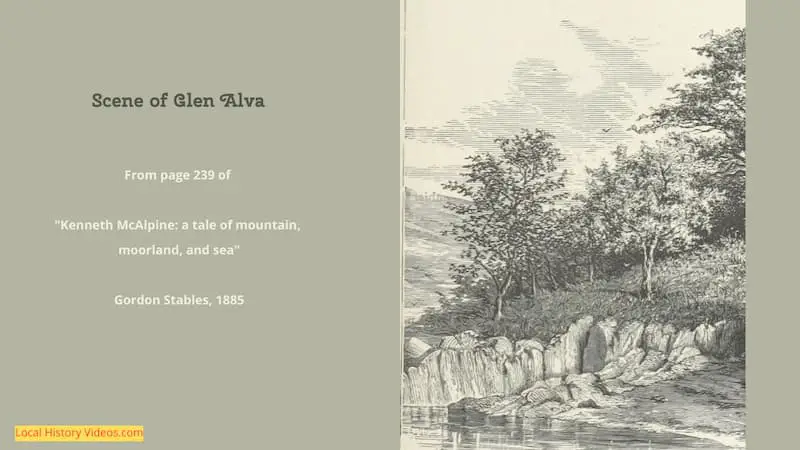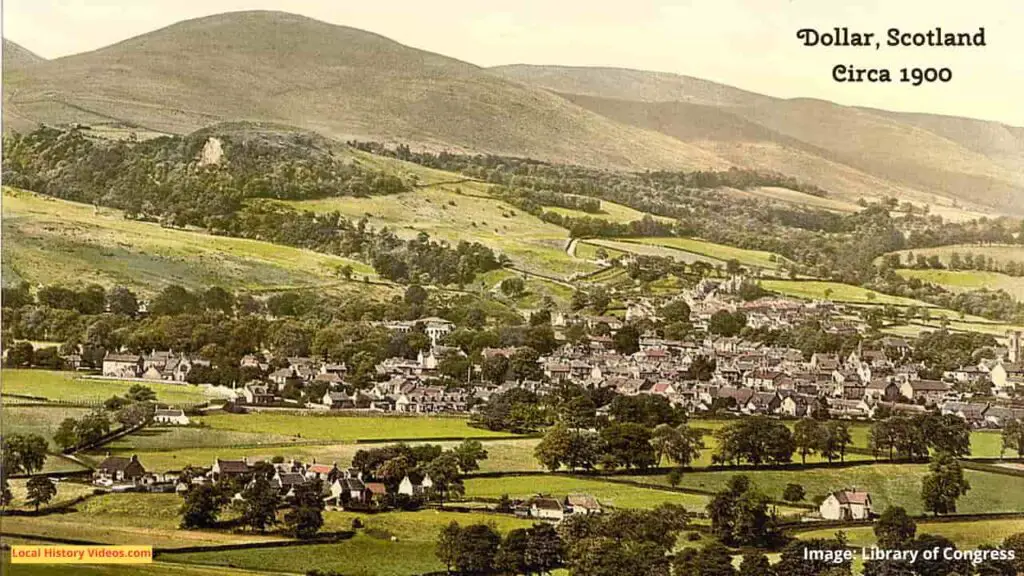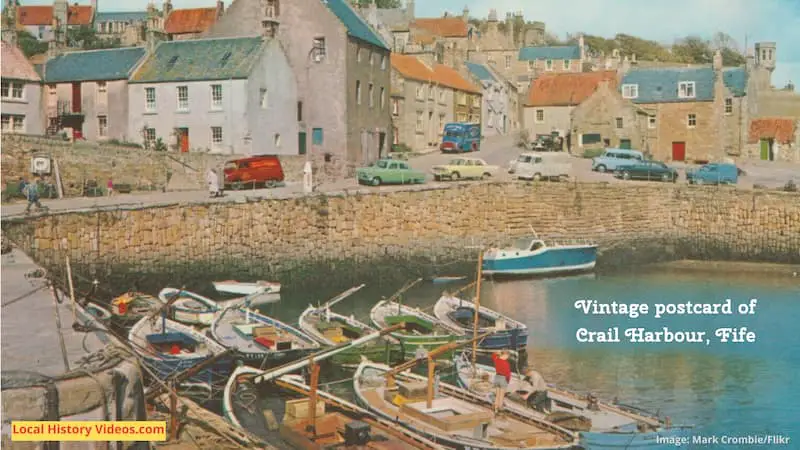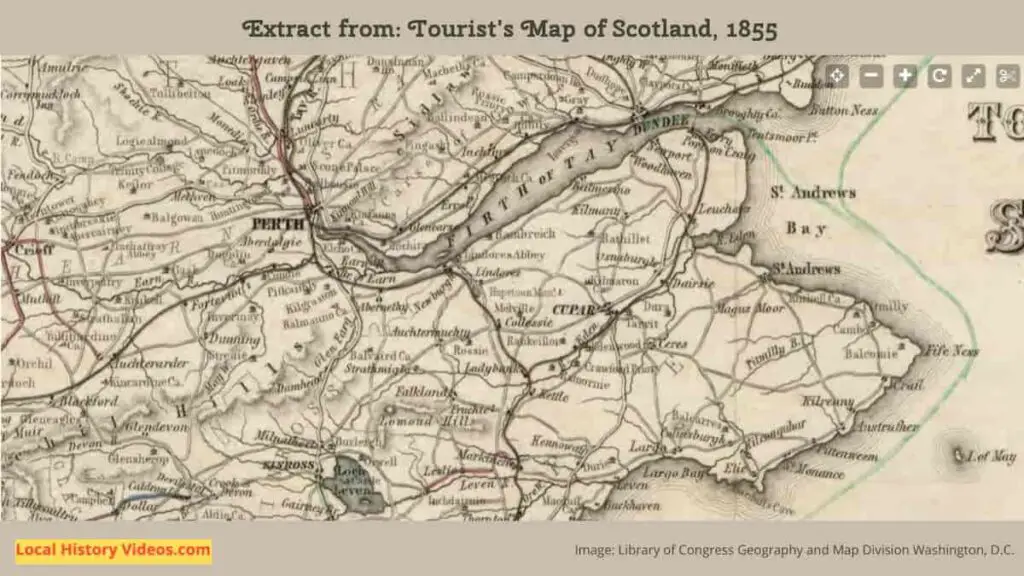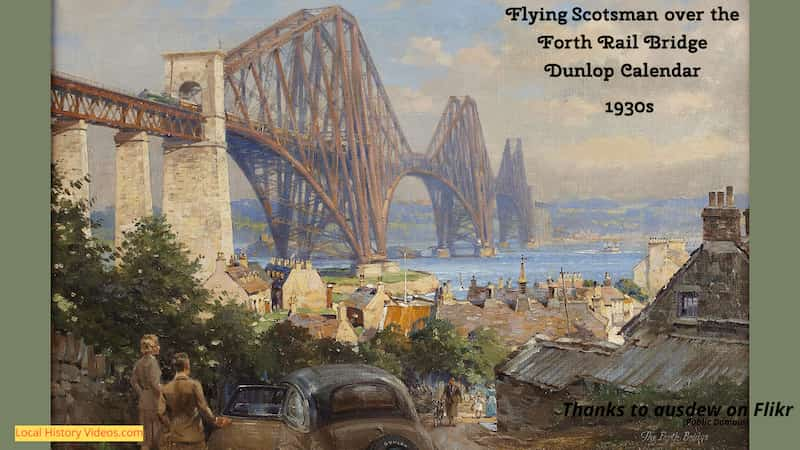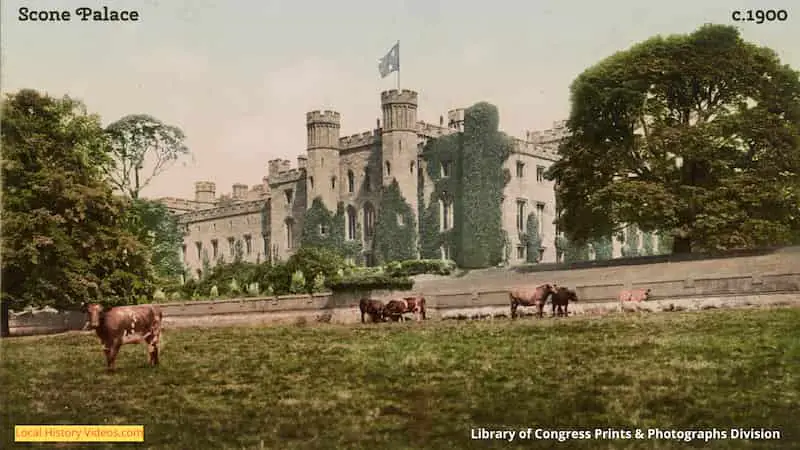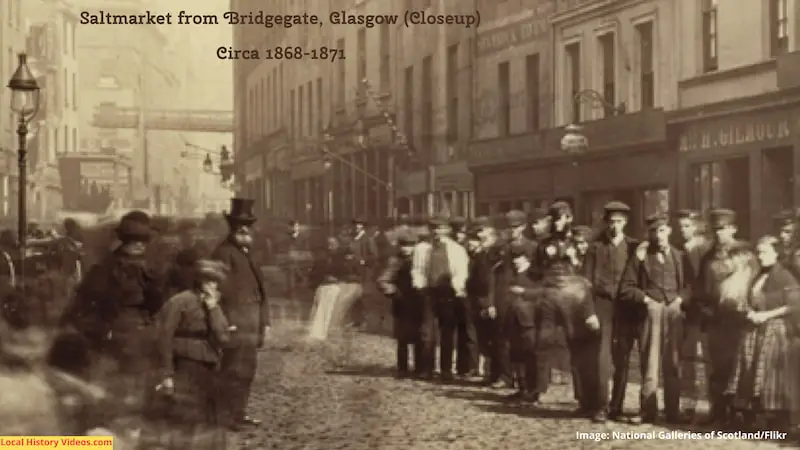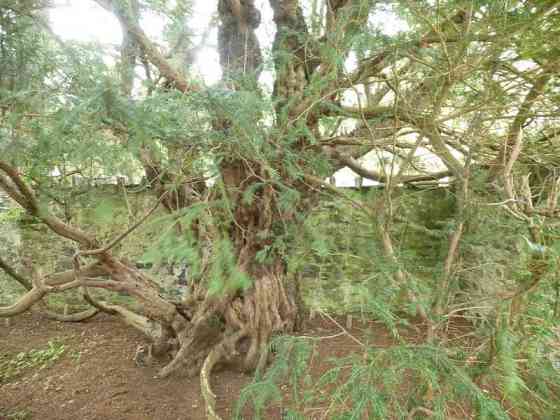Glimpse history through old images of Alva, a small town in Clackmannanshire, Scotland, close to the waterfall of Alva Glen.
Alva House
Alva House was a tower house, built in 1542. In 1636, Sir Charles Erskine extended and remodelled it.
In 1800, the house passed from the Erskine family to James Johnstone, a mill owner.
Textile Manufacturing
During the Industrial Revolution, Alva’s water sources were put to good use as power for the woollen mills. People now moved to the area to find work in the new industry.
In 1874, the Dalmore Works were built for the Wilson brothers. Their products included tweed, mohair and woollen rugs, and woollen novelty fabrics. The works shut in 1964.
Strude Mill was the town’s largest mill. It was built in 1825, and is six storeys high. Today, it contains modern flats close to public transport and local facilities.
Old Photos of Alva
Enjoy a video showcase of old photos of the Clackmannshire town.
Old Photographs Of Alva Clackmannanshire Scotland: Tourscotland (YouTube)
The Alva Games
The annual Alva Games have their foundation in a gymnastics display which took place in 1856. They remained in the same location for more than 150 years, but quickly became a bigger affair than the original gymnastics gathering.
They are now Clackmannshire’s last surviving sports and games.
Old Books About Alva
Alva in 1880
“The History of Stirlingshire”, by the Rev. William Nimmo (Minister of Bothkenna) and the Rev. Robert Gillespie (Minister of Port), was published in 1880 by Hamilton, Adams & Company.
It was an update to the original version published in 1817, printed by John Fraser, for Andrew Bean, a Bookseller in Stirling.
The following excerpts from the book show mentions of Alva’s location and community.
Pages 1, 2 and 3:
Alva belonged in ancient times to Clackmannanshire, with which it has been politically in-corporated since the passing of the Reform Bill. Since the beginning of the seventeenth century, however, it has been attached for judicial purposes to Stirlingshire, although upwards of four miles distant from its nearest point. The barony is surrounded on all sides by the shire of Clackman-nan, except on the north, where it is bounded by a part of the county of Perth. From the chartulary of Cambuskenneth, we learn that Alva was a parish nearly 600 years ago, although it does not appear certain when the building of the village was first started. In the year 1795, the latter only contained 130 families, including a few single persons, each of whom occupied part of a house. The population of the parish in 1791 was 611; in 1801, 787; in 1811, 921; in 1821, 1,197; in 1831, 1,300; in 1836, 1,470; in 1841, 2,136; in 1851, 3,204; in 1861, 3,618; and in 1871, 4,296. For a considerable period prior to the Reformation, Alva was in the diocese of Dunkeld, and under the ecclesiastical jurisdiction of the bishop of that see.
By an extract taken from the chartulary of Cambuskenneth, it appears that it was a mensel church (de mensa Episcopi), be-longing to that abbacy; and that the monks, who were of the order of St. Augustine, performed duty there, from want of a sufficient fund to maintain a resident and regular clergyman in the parish. In 1260, Richard, bishop of Dunkeld, made a donation to the monks of the church of St. Mary, at Cambuskenneth, of “the church of Alva with all its legal pertinents,” and dispensed with their employing a vicar to officiate statedly. From 1581, till 1632, this parish was united to the neighbouring one of Tillicoultry-the minister of Alva officiating in both. The fabric of the present church was erected in 1632, by Alexander Bruce, proprietor of Alva, who afterwards, making a small addition to the stipend, procured its disjunction from Tillicoultry. In the year 1815, at the expense of Mr. James Raymond Johnstone, it was wholly rebuilt, and fitted up so as to accommodate 600 sitters.
Page 12:
Logie is bounded on the north by the parish of Dunblane; on the south by the river Forth, which divides it from Stirling and St. Ninians; on the west by Lecropt and Dunblane; and on the east by Alva and Alloa. Its extreme length, from north to south, is between 6 and 7 miles; and its extreme breadth, from east to west, about 6.
The present church, which was built in 1805, is a plain unpretending structure, but neat and commodious. It is seated for 644 people. Its situation is peculiarly romantic and beautiful; and that of the old kirk (now an interesting ruin) still more so.
The population in 1831 was 1,943; in 1841, 2,198; in 1851, 2,551; in 1861, 3,468; and in 1871, 4,553.
Page 21:
The whole of Alva parish is in Stirlingshire, though about 3 miles from the nearest point of the parent county.
Page 32:
About 1700, Sir James Erskine, of Alva, had obtained, from a ravine in his estate of Alva, above £50,000 sterling’s worth of silver ore, in about fourteen weeks. The vein had now be-come exhausted, and symptoms of lead and other inferior metals had appeared, when the work was forsaken. The communion cups of the church of Alva are made of the parochial silver.
Page 41:
Page 41 of the History of Stirlingshire tells us that in 1879-80 Alva had 3 Board Schools. Average attendance was 822, the rate (the rate per £ on the rateable value of the district, of the amounts paid to the treasurer by the rating authority) was 5 1/2 d, and the Annual Grants were 640 11 7.
Page 72:
Page 72 tells us about the career and family of Sir Thomas Hope. His daughter Mary married Sir Charles Erskine of Alva.
Pages 96 & 97:
The estate of Alva was anciently possessed by the Stirlings of Calder in Clydesdale. According to Nisbet, in his first volume of Heraldry, “Sir J. Menteith, son of Sir Walter Menteith, of Rusky, married Marion Stirling, daughter and co-heir to Sir John Stirling, of Calder in Clydes-dale, and with her he got ye lands of Kerse and Alveth (Alva), for which ye family carried ye buckler for the name of Stirling, and flourished for many years.”
Sir William Menteth or Men-teath, of Alva, married Helen Bruce, daughter to the laird of Airth, and his son, Sir William Menteth, married Agnes Erskine, daughter to Alexander, Lord Erskine, whose successors after-wards, through right of their mother, inherited the earldom of Mar. The Countess of Mar and Kelly is a descendant of the family of Menteth of Rusky.
By the intermarriage before alluded to, it is highly probable that the Alva property went to the Bruce, and afterwards to the Erskine family.
In 1620 it went to Sir Charles Erskine, fifth son of John, sixth Earl of Mar. His great grandson, Sir Henry Erskine of Alva, father to the late Earl of Rosslyn, sold it in 1759 to his uncle, lord justice clerk, called Lord Tinwald, whose son, James Erskine, a senator of the College of Justice, inherited it, with the title of Lord Alva. He was one of the most energetic proprietors, with the exception of the Bruces, who founded the present mansion and church.
Lord Alva sold the estate in 1775 to John Johnstone, Esq., son of Sir James Johnstone, Bart. of Westerhall, Dumfriesshire, brother to Sir William Pulteney.
Sir John and Sir Charles Erskine, two of the Alva proprietors, were both killed when abroad in 1746.
Page 193:
Although the run of the romantic and beautiful little river is peculiarly circuitous and winding in its round of the Ochils, it flows at first almost due east towards Glendevon; but, near the church of Fossaway, it makes a sudden turn west-ward, and passing through the parishes of Muck-hart, Dollar, and Tillicoultry, gently glides along the southern boundary of Alva district. It is some-what odd, that the stream, after having performed a circular route of about 30 miles, should end its career nearly opposite the point at which it started on the other side of the hills, reaching the Forth exactly where the latter assumes the character of a firth, two miles above Alloa.
Pages 217 and 218:
That portion of the Ochils which extends into the parish of Alva, when seen at some distance from the south, appears to be one continued range, with little variation in height; but, as the mountain slopes towards the south, it is intersected by exceedingly deep and narrow glens.
From this circumstance the foreground is divided into three separate hills, distinguished by the names of Wood Hill, Middle Hill, and West Hill of Alva. Wood Hill rises immediately from its base to the height of 1,620 feet, and continues still rising gradually for about two miles further north, until it reaches the top of Ben-cloch, or Bencleugh, the highest point of the Alva hills; and the summit of all the Ochils being, according to an observa-tion, 2,420 feet above the level of the river Devon, and 2,300 feet above the level of the Forth at Alva.
The view from this summit is very exten-sive; but the Wood hill, the Middle, and the West hills are incomparably the most beautiful of the whole range, from Glen-Devon on the east, to their termination near the bridge of Alva on the west. They are not so steep, rugged, or in-accessible as those immediately westward in the parish of Logie, and they present a more regular, noble, and bold aspect than any of those that lie immediately on the east; besides which they are clothed with the richest verdure at all seasons, and produce grass of the finest quality and in the greatest variety.
Pages 236 and 237:
The rarest animal found in Alva parish is the Falco peregrinus. For ages, this bird has had its residence on a very high perpendicular rock, called Craigleith, projecting from the brow of the Westhill of Alva. Only one pair, it is affirmed by the villagers, build in the front of this precipice. These hatch annually; and when the progeny are of proper age, the parents compel them to seek another habitation-death alone obliging the old or original pair to resign their ancestral quarters, which fall to their next sur-vivors.
In ancient times,’when “lords and ladies gay” were fond of the sport of falconry, a bird of this species was deemed valuable. From Craigleith, Queen Mary got falcons after her arrival from France; and gentlemen, in several parts of England, have repeatedly sent for these birds, to tame them, from the nest, for hunting. Eagles are now rarely seen among the Ochils.
Pages 269 and 270:
There are 7 farms in Alva parish, all which are possessed by James Johnstone, Esq.
Strude, £503; Balquharn, £414; Myreton, £365; Burnside, £364; Carsiepow, £250; Boll, £170; Greenhead, £146; and lands of East and West Bank, £74 – annual valuations in all, £2,286.
Page 278:
The tract of country along the foot of the Ochils is well known for its rare fertility. The acreage within the shire, from Stirling on to Alva, is 9,176, with a valuation of £48,670, being an average of about five guineas per acre.
Pages 326, 327 and 328:
Yarn spinning and woollen manufactures are confined for the most part to Alva, Stirling, and Bannockburn.
Up till 1829, blankets and serges were the only goods produced in the first-mentioned village, when the manufacture of shawls was introduced.
There are nine spinning-mills in the place, employed on yarns for making shawls, tartan dress goods, tweeds, &c.
The mills contain 37 sets of carding-engines, driven by steam and water power. The number of persons engaged is about 220; and the amount of raw material put through in the course of a year is valued at £123,000.
Some of the yarn is used in the locality, but the greater part of it goes to agents in Glasgow.
The weaving of shawls, handkerchiefs, plaids, and shirtings is the staple trade of the village, and gives employment to about 700 journeymen and 100 apprentices in the busy season, besides from 500 to 600 women who do the winding, twisting, and finishing.
A number of young boys are also employed as drawers and twisters.
Since shawls and tartans ceased to be fashionable articles of female attire, and since the closing of the ports of the United States to our manufactured goods, trade has been limited to a few months of the year; and that circumstance presses hard on those employed in the weaving business, who generally seek work during the winter months in Galashiels, Selkirk, and Hawick.
The value of the manufactured goods runs from about £200,000 to £250,000 annually. The chief market is Glasgow, but a considerable quantity also goes to Manchester, London, and some of the principal Irish towns.
(There is some information at this point on page 327 about the ancient woollen trade of Tillicoultry, not reproduced here).
Towards the end of the eighteenth century, the current of manufacturing enterprise in Tillicoultry seems to have become stagnant, and the making of serges was transferred to Alva; though it would appear from the old “statistical account” that a market for Alva goods was not easily obtained, it being a common saying that “a serge web from Alva would not sell in the market while one from Tillicoultry remained unsold.”
Notwithstanding such preference, Alva ultimately carried the trade in that class of goods.
The 1817 Second Edition
The 1817 Second Edition of the History of Stirlingshire has some paragraphs which were updated for the 1880 version, or sections which were later dropped altogether.
Pages 133 and 134
The barony of Cambuskenneth, in which the monastery stood, was settled, by the Earl, upon Alexander Erskine of Alva, his brother, whose posterity continued in possession of it till the year 1709, when it was purchased by the town-council of Stir-ling for the benefit of Cowan’s hospital, which it still belongs.
Pages 528 and 529:
We may close this long section with what had escaped us in its place. Alva had been in the possession of cadets of the Marr fa-mily from before the middle of the 17th century. The last of the Erskines of Alva was a senator of the College of Justice, first as Lord Barjarg, and afterwards as Lord Alva. His father, Erskine of Tinwald, had been Lord Justice Clerk; and bought Alva, of his nephew Sir Henry Erskine, in 1759.
The Justice Clerk has a marble monument at the east end of the church of Alva. The late Lord Alva sold his estate of this name to Mr Johnston, father of the present Mr Johnston of Alva.
Page 583:
For particulars see Report by Dr Graham. He considers the mosses of Alva and Slamannan as impracticable.
Page 735:
At the northern extremity of Queenshaugh, a curious relic was, about 1790, dragged out of the river. It was a brass collar with this inscription, “Alexander Steuart found guilty of death for theft at Perth, 5 December 1701, and gifted by the Justiciars, as a perpetual servant to Sir John Aresken of Alva.” It is in the possession of the Antiquary Society of Scotland.
Pages 739 and 740:
Alva, anciently Alueth, probably another form of Aluin, meaning ‘beautiful,’ was ‘mensal’ of Dunkeld (de mensa Episcopi, part of the funds for the Bishop’s support); and the duties of it were performed by the monks of Kambuskinel, who obtained, as compensation, the whole of the benefice, in 1290. Chartulary of Cam-buskenneth.
Alexander Dominus de Stirling Miles granted one acre of land to God, the Virgin Mary, St Servanus, and the church of St Servanus de Alueth, describing it as lying inter ipsam fontem’ (St Serf’s well) et ecclesiam.
The well is in the Minister’s glebe. Ibid. From 1581, the year when the Presbytery of Stirling was erected, till 1632, Alva was united to Tillicoultry.
Statistical Account, XVIII, 138. Population in 1811, males 441, females 480, total 921.
More about Scotland
- Old Images of Dollar, Scotland
- Old Images of Fife, Scotland
- Old Images of the Edinburgh Festival
- Old images of Isle of Lewis, Outer Hebrides
- Old images of Edinburgh, Scotland
- Old Images of Alva, Scotland
- Old Images of Cellardyke
- Old Images of the Forth Bridge at Queensferry
- Old Images of Scone, Perth & Kinross
- Old images of Kelso in the Scottish Borders
- Old Images of St Kilda
- A Visit To The Fortingall Yew, Perthshire
- Linlithgow History: Old Photos & Film
- Dunfermline, Fife: Old Photos & Films
- Clydebank, Scotland: Old Photos & Films
- Alloa, Scotland: Old Photos & Films
- Glasgow, Scotland: Old Photos & Film
- Old Images of Dundee, Scotland
- The Oldest Trees In The UK

